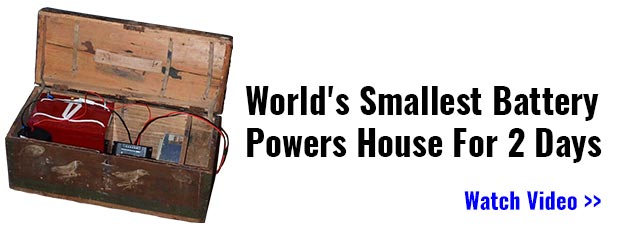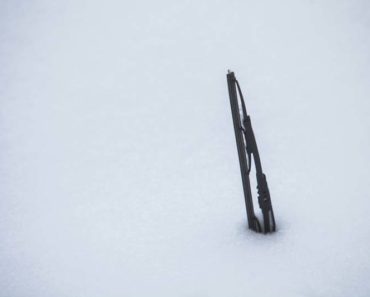One of the biggest problems that can possibly face us in a post-TEOTWAWKI world, especially one in which the grid has gone down is what to do about motive power.
Modern society has adapted itself to the use of the internal combustion engine and electric motors for power. Should we be faced with a grid-down situation, such as an EMP or CME, we would not only lose the use of electronic devices, but all power as well. Even if our cars and trucks survived the event, petroleum can’t be pumped out of the ground or refined into usable products without electricity. So it won’t take long for whatever fuel reserves there are to be used up.
Portable Device Generator – Learn How To Build Your Own Energy Generator!
Many people have said that if such a thing were to happen, we would be going back to living in the 1800s. But that’s only true to some extent. While we would have to do things like they did back in the 1800s, before the electric motor and internal combustion engine, we wouldn’t really have the ability to. Not only do we not have the tools available, or the knowhow, we don’t have the horses.
Before the automobile became our main means of locomotion, horses were the most common form of motive power in existence. While not the only form of power used, horses were essential to farming, delivery of goods and general transportation. Not only that, but many factory operations, such as machining, were accomplished by harnessing the power of horses driving a windlass. That power then turned an overhead axle, with leather belts carrying the power to various machines.
But at the beginning of the 1900s, just when the automobile was being introduced, there were 25 million horses in the United States. That was for a population of 76.09 million people. So we can say there was roughly one horse for every three people, a bit more than one per family. But today there are only 9 million horses in the USA, with a population of 331 million people. That’s one horse for every 33.8 people. Doesn’t sound like anywhere near enough for transportation in a post-disaster world, let alone any of the other ways we’ll need to use them.
Besides the small horse population that exists today, there is the problem of cost. Horses are considerably more expensive today, than they were even 50 years ago, even if you count for inflation. Seen as a luxury item, horses aren’t seen as something where the price really matters, other than to the sellers. With less horses to sell and less horse buyers, prices have increased. On top of that, caring for a horse requires land, a stable and the other costs of caring for the horse.
All this makes it more or less impossible for most of us to include horses in our preps. Yet if the ultimate disaster, a grid-down situation, were to occur, we would need those horses or something else to take their place.
Of course, horses weren’t the only source of motive power in use back then. The other major source of motive power was the waterwheel. But waterwheels can only be installed where there is flowing water to use. This limits them severely, as few businesses or individuals have a flowing river bordering their property.
Then there were the less-common sources of power, such as wind and human power. Galleys, rowed ships that were common from the late second millennium BC up until the early part of the 19th century, used human power. Contrary to modern understanding, few of those ships were actually powered by slaves, but instead were powered by soldiers or paid seamen, up until the early 16th century. In cases where slaves were used, it was usually due to an emergency, with the slave winning their freedom through that service.
Yet human power is limited, especially when we consider that people will have less to eat in such a time. Trying to grow food, where humans have to turn the ground by hand, rather than with the aid of a plow or any other farm machinery, will be extremely difficult, let along doing any of a million other things which require motive power.
If we’re going to survive such a scenario, especially in the long-term, we’re going to have to come up with some other options.
Animal Power
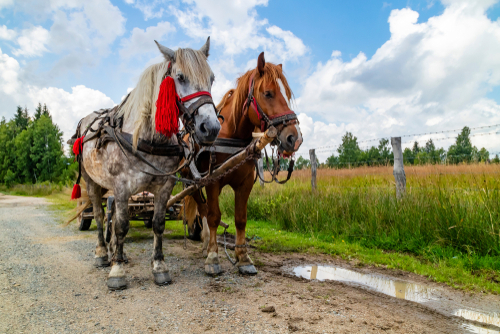
While horses are the main animal which has been domesticated for use as motive power, they are by no means the only ones which have been. Throughout history, mankind in various parts of the world have sought to harness various different types of animals, from dogs at the small end to elephants at the big end. A wide variety of animals, such as oxen, water buffalo, yak, camels, donkeys and mules have been used extensively as draft animals. But they aren’t the only ones.
Literally any four-legged animal which can be tamed can be used as a draft animal. The only real question is how much weight they can pull. Eskimos have long used dogs, especially huskies (although there are several other breeds used as well), to pull their sleds. A minimum of four dogs are required to pull a sled, but the weight would be limited. Some sleds use as many as 11 dogs to pull heavier loads.
In the wake of a grid-destroying event, animal power will probably be the quickest thing to turn to, besides human power. But we shouldn’t just limit out thinking to the horse. There are a number of other options to consider.
The big question on these other options, is whether it will be better to use them to help us grow food or use them as food. That’s going to be a difficult one; but in the long run, we’re better off if we can use the animals to help us grow food, rather than finding ourselves forced to slaughter them for food.
Dogs
Probably the fastest and easiest source of animal power to find will be dogs. There are always plenty of strays around, which can be enticed to join your family. The big problem will be feeding them. But if you can find a way to feed them, those dogs can be harnessed together and be taught to pull a small cart. Enough of them could probably even pull a plow, but that would probably require two people, one to lead the dogs forward, while the other managed the plow.
While this might not be an ideal option, I mention it mostly because of its availability. Don’t discount it unless you have another option; and if you already have a large dog or two, you might want to experiment a little with seeing how much of a cart they can manage to pull.
Oxen
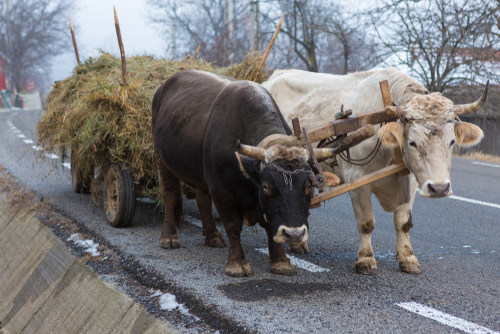
The other big source of animal power in the 1800s was oxen. Oxen are nothing more than adult steers, in other words, bulls that have been castrated. There are something like 95 million cattle in the United States today, making them the most prevalent potential source of animal power there is. While there are more dogs around, not all of those dogs have the strength to pull much more than a toy car. Even those which can pull a small cart, can’t pull anywhere near as much as an ox can.
Oxen were actually in common use in the Old West, both to pull the prairie schooners used in wagon trains and to pull plows. While slower and not as nimble as horses, these animals can easily pull their body weight and sometimes as much as double their body weight, especially when harnessed together in teams.
The good news is that there are so many cattle around, which could be converted to use for farm work, if they aren’t killed outright for food. In my opinion, bartering for an ox or two, just after an EMP, would be an excellent use of barter goods, especially if you own enough land to make use of their power in pulling a plow.
Deer
One of the more surprising options that we should consider is the use of deer and all their cousins; elk, moose, reindeer, and caribou. While most people will be hunting these animals for food, domesticating them and training them for farm work might actually be a more effective use of them in the long term.
We’ve all heard of Santa Clause using reindeer to pull his sleigh. But Santa isn’t the only one who has done this; it was done extensively in Alaska and Northern Canada, mostly for pulling sleighs. But if an animal can pull a sleigh, it only makes sense that they could pull a wagon or cart as well. We just need to gauge how much weight they can pull comfortably, so as to not put too much strain on the animals.
Wind Power
We normally only look at wind power for the purpose of producing electricity; but that’s not the only way that wind has been used or even is used today for power. Many ranchers still use wind power for pumps, bringing up subterranean water for their stock to drink. These windmills, like those that Don Quixote tried to kill with his lance, are providing automatic power for pumps, where no other power exists.
The big problem with wind power is that it is limited. First, you need to be in a place where there is enough wind to make it worthwhile. Typically 10 mph winds are needed to create electricity. That would be appropriate for other needs as well. But then, the windmill itself has to be big enough to generate enough torque to run anything more than a small pump or electric generator.
Wind power has been used for running gristmills, grinding grain, since about 200 BC. In more recent times, they have also been used for powering sawmills, where there wasn’t water available for a waterwheel. If a windmill can be made that will power a gristmill or sawmill, it will power just about any other tool we can imagine.
Of course, the windmills needed to power these mills are massive; not as big as the ones being used to produce electric power commercially, but as big as the ones that Don Quixote thought were monsters. The good news is that such windmills can be built by hand, using nothing more than manual tools.
Wind Powered Transportation
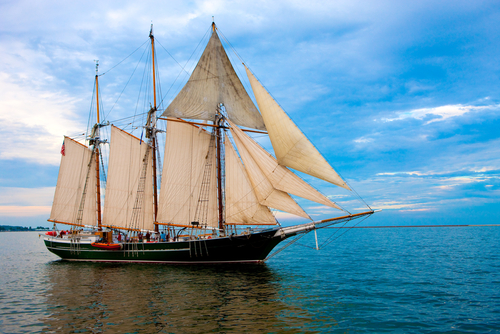
The other historic use of wind power is for transportation. The age of sail was a great era for exploration and trade. While the sailing ships of those days were considerably smaller than anything we have today; they didn’t require any fuel other than the wind. Wind power can be used for ships on the open ocean, as well as on our country’s many rivers. In Holland, wind-powered ice boats were used to haul goods, when the canals froze over.
A spinoff from sail is land sailing. A land sailing yacht is a three-wheeled vehicle, powered by a sail. The front wheel is for steering, controlled by the feet on a T-bar. At the same time, a rope is held in the hands, allowing control of the sail. Adjustment of the sail’s angle affects how much wind it can catch, which converts directly to speed.
Today, land sailing is only an unusual sport, requiring huge open spaces, such as dry lake beds and abandoned airports. However, in a post-EMP world, land yachts could be made larger and adapted for use on the highways, perhaps becoming one of the primary means of transporting goods. While they would be limited in how much they could carry, the speed of land yachts might make them a good choice in this sort of scenario.
Water Power
We’ve probably all looked into the value of water power, should we ever be faced with a grid-down situation. Of all the renewable energy sources in the world today, hydropower has and still does produce the most electricity. Countries which claim to be 100% renewable energy are basically powered by hydropower, no matter how many solar farms and wind farms they claim to have.
Historically, water power has been used for much more than just making electricity. Every mechanical operation in the 1800s was adapted to water power, when available. This included gristmills, sawmills, machine shops, cotton gins and a host of different types of factories, especially in the textiles industry. Water power was the main motive power in the early days of the industrial revolution.
Fire (Steam) Power
It wasn’t actually the internal combustion engine that became the death knell of water power, but the steam engine. Early railroads used steam locomotives for power and some of the earliest cars were powered by steam. But steam could be readily adapted to much more, providing power to a wide range of factories. When electric motors and internal combustion engines came upon the scene, it was to replace steam engines, not waterwheels.
Steam power will likely become a major part in the rebuilding of America if such a grid-down event ever occur. Steam power carries the advantage that any form of heat can be used to generate the steam; it is not limited to only one sort of fuel. Even solar power can be used, if it can be concentrated enough to boil water.
There are still family-owned farms today which use steam-powered tractors to till their fields. While you’re not likely to find a steam tractor in your local junkyard that you could rebuild, it would be much easier to build one from available materials than to build an internal combustion engine. By comparison, the steam engine is considerably simpler.
Steam engines will also help power the rebirth of industrialization. Having an understanding of this technology and how to build simple steam engines could make you very valuable to your community, in the wake of such a disaster.

